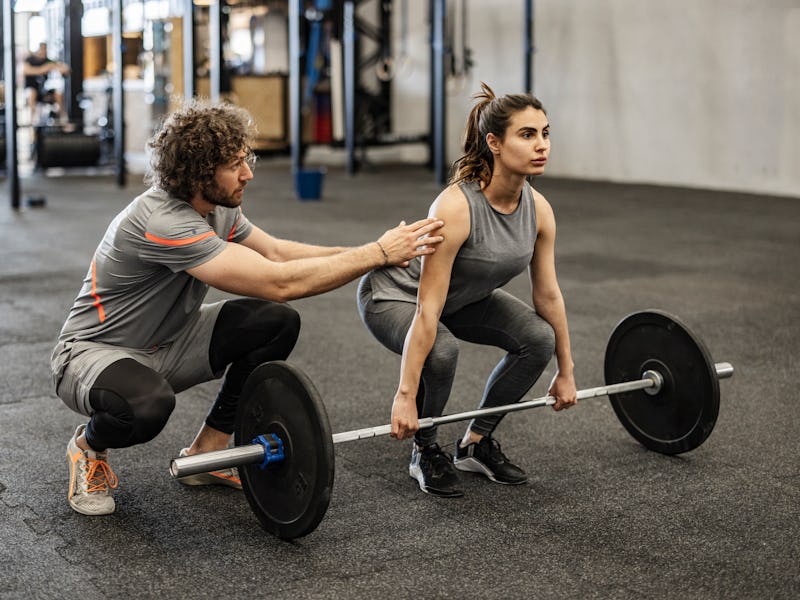Mindfulness plays a crucial role in lifting — here’s how to do it right
Research shows that mental training can increase gains at the gym.

Watch enough powerlifting competitions or heavy weights lifted at the gym and you’ll see a pattern: A lifter breathes in deeply, focuses their eyes, and exhales before maneuvering into their proper position under the bar. The ritual is meant to prepare the mind before the body tests itself. While techniques vary — some lifters need one breath; others need more — the focus reset before a rep is about as static a tradition as there is in lifting.
These behaviors can even be seen as part of the lift: Instructions on squatting, if they’re good, will include setting up the breath and an eye line before beginning the exercise. In other words, these aren’t optional moves, but key components that bind the mental work with the physical act. So is there an ideal way to maximize mental focus before a lift?
The long history of mindfulness in lifting
Lifting has a long intertwined history with mindfulness work, with most of its mental focus approaches disguised, in the literature, as vague steps needed to perform the physical act. (Sometimes the connection is more direct, like Arnold Schwarzenegger’s reliance on transcendental meditation.) Squat instructions, for instance, tend to have a lifter take a deep breath, focus on one point in space, and exhale throughout the exercise so they’ll move better. The inhalation stiffens the core, and the focus in front stacks the body and forces a neutral head angle throughout; you have to do all these things to squat safely.
But these approaches also help focus a lifter on paying full attention to a complicated, difficult movement. Creating a reliable routine on every squat taken — be it a max effort lift or empty bar warm-up — flattens and simplifies it to a movement, where it’s less about the weight and more the full movement. (There’s an old lifting maxim: Move heavy weights like they are light, and light weights like they are heavy.) Eventually, this process improves: After repeatedly cueing our breath and our vision, the movement clicks so that we don’t have to think about it.
Less stress yields better results
Research has also shown that other forms of mental training can increase gains at the gym. One of those methods is positive verbalization. In a study, two groups of kickboxers performed bench presses, half squats, medicine ball throws, and countermovement jumps, with one group performing motivational self-talk during the sets, and 30 minutes of mental exercises after. Over time, the self-talkers performed substantially better than the control group, and also showed better heart rate and blood pressure markers.
The study attributed these changes to lower hormonal and physiological stress levels: Talking about things positively seems to have a calming effect. (Meditating also appears to have a similar effect on stress.) Doing something as simple as repeating, “I can squat this thing easy” can’t hurt to try out before leg day.
Another method is internal visualization. Envisioning yourself squatting a weight safely and confidently may make that movement seem more familiar. Studies have shown lifting can help reduce anxiety, but visualization is even more distilled: Since the brain gets recruited on a max-effort squat, why not take it for a test run, without any weight?
Those mental reps can improve our neural adaptation, or the mind-muscle connection, which improves when neuromuscular pathways become “familiar” with the movement after repeated reps. Could the mental acuity tasks in the kickboxing study speed up the neural connection in the same way that doing more reps might? That’s outside the realm of the study, but there might be a case here: Visualizing yourself lifting more weight than you can make the entire exercise less foreign.
How internal and external focus meld
There’s also a relationship between internal focus — on the mind and body and how it feels during a lift — and external focus when attention is paid to the mechanics of the movement itself. A review study, published in Frontiers in Sports and Active Living, concluded that performance, at both the “neuromuscular and behavioral level” is influenced “by the attentional foci that an athlete adopts.” Its author, David Neumann, a researcher at Griffith University in Australia who focuses on learning and performance, tells me that “the more complex the movement is, [for example,] compound lifts like the snatch and clean and jerk, the more important mental approaches will be”.
After that, it gets complicated: There’s a difference between external and internal foci—results, like the amount of weight moved as well as time, and sensations, like pain and breath, respectively—and what focusing on each seems to do. Long-term, Neumann says it’s “conceivable that an internal focus will increase muscle mass relative to an external focus,” or that if we focus on our breath, and how we feel, we may lift more weight than if we focus on poundage.
Bringing everything together
How we focus our attention seems to have a real effect not only on how we move but how well we move. It’s no coincidence that the best approaches to lifting have a real mental component, and the best programs focus on volume. Paying close attention to how every rep is done, and doing it often, improves neural adaptation and gets people stronger. But visualizing the exercise, when the weight starts to get heavy, is helpful as well. Imagining a max effort lift won’t break a PR, but it can’t hurt if you’re also doing everything else. When we get under the bar, it can’t be the first time — even if it’s something we’ve never done before.